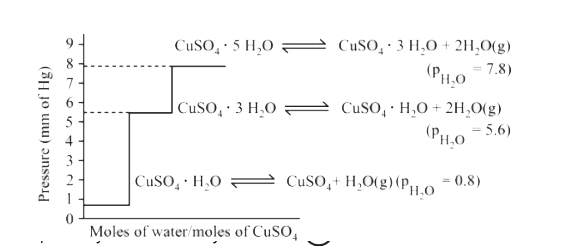Dehydration of salts is an important class of heterogeneous reactions. The salt hydrates during dehydration often dissociates in steps to form a number of intermediate hydrates according to the prevailing pressure of moisture in contact with the solid hydrates. Thus copper sulphate pentahydrate on dissociation yields trihydrates, monohydrates and then the anhydrous salt in the above order as follows :Q. The equilibrium constant KP for the equilibrium between

7.8
60.84
31.36
5.6
The correct Answer is:B
CuSO4.5H2O→CuSO4.3H2O+2H2O(g)
PH2O=7.8mm⇒Kp=(PH2O)2=(7.8)2=60.84
Similar Questions
Dehydration of salts is an important class of heterogeneous reactions. The salt hydrates during dehydration often dissociate in steps to form a number of intermediate hydrates according to the prevailing pressure of moisture in contact with the solid hydrates. Thus, copper sulphate pentahydrate on dissociation yield trihydrates, monohydrates and then the anhydrous salt in the above order as follows:

The equilibrium constant Kp for the equilibrium between pentahydrate and trihydrate is:
View SolutionDehydration of salts is an important class of heterogeneous reactions. The salt hydrates during dehydration often dissociate in steps to form a number of intermediate hydrates according to the prevailing pressure of moisture in contact with the solid hydrates. Thus, copper sulphate pentahydrate on dissociation yield trihydrates, monohydrates and then the anhydrous salt in the above order as follows:

The ratio of equilibrium constant between pentahydrate and trihydrate and equilibrium between trihydrate and monohydrate is
View Solution
Knowledge Check
Dehydration of salts is an important class of heterogeneous reactions. The salt hydrates during dehydration often dissociate in steps to form a number of intermediate hydrates according to the prevailing pressure of moisture in contact with the solid hydrates. Thus, copper sulphate pentahydrate on dissociation yield trihydrates, monohydrates and then the anhydrous salt in the above order as follows:

The equilibrium constant Kp for the equilibrium between pentahydrate and trihydrate is:A7.8B60.84C31.36D5.6Dehydration of salts is an important class of heterogeneous reactions. The salt hydrates during dehydration often dissociate in steps to form a number of intermediate hydrates according to the prevailing pressure of moisture in contact with the solid hydrates. Thus, copper sulphate pentahydrate on dissociation yield trihydrates, monohydrates and then the anhydrous salt in the above order as follows:

The ratio of equilibrium constant between pentahydrate and trihydrate and equilibrium between trihydrate and monohydrate isA1.9B2.9C8.6D5.6Dehydration of salts is an important class of heterogeneous reactions. The salt hydrates during dehydration often dissociate in steps to form a number of intermediate hydrates according to the prevailing pressure of moisture in contact with the solid hydrates. Thus, copper sulphate pentahydrate on dissociation yield trihydrates, monohydrates and then the anhydrous salt in the above order as follows:

Which of the following conditions is favourable for dehydration of CuCO4.5H2O?
i. Low humidty in air
ii. High temperature
iii. pH2O increases
The correct option is:AiBi, iiCii, iiiDi, ii, iii
Dehydration of salts is an important class of heterogeneous reactions. The salt hydrates during dehydration often dissociate in steps to form a number of intermediate hydrates according to the prevailing pressure of moisture in contact with the solid hydrates. Thus, copper sulphate pentahydrate on dissociation yield trihydrates, monohydrates and then the anhydrous salt in the above order as follows:

Which of the following conditions is favourable for dehydration of CuCO4.5H2O?
i. Low humidty in air
ii. High temperature
iii. pH2O increases
The correct option is:
View SolutionIf a springly soluble salt is placed in water, after some time an equilibrium is established when the rate of dissolution of ions form the soid equal to the rate of precipitation of ions from the saturated solution at a particular temperature. Thus, a dynamic equilibrium exists between the undissociated solid species and the dissolved ionic species in a saturated and the dissolved ionic species in a saturated solution at a particular temperature. For example, in AgCl, we have the following equilibrium:
AgCl(aq.)Ag+(aq)+Cl−(aq)
The equilibrium constant
Keq=[Ag+][Cl−][AgCl]
Keq×[AgCl]=[Ag+][Cl−]
⇒Ksp(AgCl)=[Ag+][Cl−]........(A)
∵[AgCl] is constant
If there would not have been a saturated solution, then from equation (A),Keq.[AgCl]≠Ksp, but Keq.[AgCl]=QAgCl, where Q is ionic product, it implies that for a saturated solution,
Q=Ksp
Ksp is temperature dependent.
When Q<Ksp, then the solution is unsaturated and there will be no precipitate formation.
When Q=Ksp, then solution will be saturated, no and ppt. will be formed
When Q>Ksp, the solution will be supersaturated and there will be formation precipitate.
Slaked lime, Ca(OH)2(s)⇔Ca2+(aq)+2OH−(aq):
Ksp=5.5×10−6
View SolutionIf a springly soluble salt is placed in water, after some time an equilibrium is established when the rate of dissolution of ions form the soid equal to the rate of precipitation of ions from the saturated solution at a particular temperature. Thus, a dynamic equilibrium exists between the undissociated solid species and the dissolved ionic species in a saturated and the dissolved ionic species in a saturated solution at a particular temperature. For example, in AgCl, we have the following equilibrium:
AgCl(aq.)Ag+(aq)+Cl−(aq)
The equilibrium constant
Keq=[Ag+][Cl−][AgCl]
Keq×[AgCl]=[Ag+][Cl−]
⇒Ksp(AgCl)=[Ag+][Cl−]........(A)
∵[AgCl] is constant
If there would not have been a saturated solution, then from equation (A),Keq.[AgCl]≠Ksp, but Keq.[AgCl]=QAgCl, where Q is ionic product, it implies that for a saturated solution,
Q=Ksp
Ksp is temperature dependent.
When Q<Ksp, then the solution is unsaturated and there will be no precipitate formation.
When Q=Ksp, then solution will be saturated, no and ppt. will be formed
When Q>Ksp, the solution will be supersaturated and there will be formation precipitate.
The solubility product of ferric hydroxide in aqueous solution is 6×10−38 at 298K. The solubility of Fe3+ ions will increase when the :
View SolutionIf a springly soluble salt is placed in water, after some time an equilibrium is established when the rate of dissolution of ions form the soid equal to the rate of precipitation of ions from the saturated solution at a particular temperature. Thus, a dynamic equilibrium exists between the undissociated solid species and the dissolved ionic species in a saturated and the dissolved ionic species in a saturated solution at a particular temperature. For example, in AgCl, we have the following equilibrium:
AgCl(aq.)Ag+(aq)+Cl−(aq)
The equilibrium constant
Keq=[Ag+][Cl−][AgCl]
Keq×[AgCl]=[Ag+][Cl−]
⇒Ksp(AgCl)=[Ag+][Cl−]........(A)
∵[AgCl] is constant
If there would not have been a saturated solution, then from equation (A),Keq.[AgCl]≠Ksp, but Keq.[AgCl]=QAgCl, where Q is ionic product, it implies that for a saturated solution,
Q=Ksp
Ksp is temperature dependent.
When Q<Ksp, then the solution is unsaturated and there will be no precipitate formation.
When Q=Ksp, then solution will be saturated, no and ppt. will be formed
When Q>Ksp, the solution will be supersaturated and there will be formation precipitate.
At 250C, will a precipitate of Mg(OH)1 form when a 0.0001 M solution of Mg(NO3)2 is adjusted to a pH of 9.0 ? At what minimum value of pH will precipitation start?
[Given : Ksp(Mg(OH)2)=10−11M3]
View SolutionIf a springly soluble salt is placed in water, after some time an equilibrium is established when the rate of dissolution of ions form the soid equal to the rate of precipitation of ions from the saturated solution at a particular temperature. Thus, a dynamic equilibrium exists between the undissociated solid species and the dissolved ionic species in a saturated and the dissolved ionic species in a saturated solution at a particular temperature. For example, in AgCl, we have the following equilibrium:
AgCl(aq.)Ag+(aq)+Cl−(aq)
The equilibrium constant
Keq=[Ag+][Cl−][AgCl]
Keq×[AgCl]=[Ag+][Cl−]
⇒Ksp(AgCl)=[Ag+][Cl−]........(A)
∵[AgCl] is constant
If there would not have been a saturated solution, then from equation (A),Keq.[AgCl]≠Ksp, but Keq.[AgCl]=QAgCl, where Q is ionic product, it implies that for a saturated solution,
Q=Ksp
Ksp is temperature dependent.
When Q<Ksp, then the solution is unsaturated and there will be no precipitate formation.
When Q=Ksp, then solution will be saturated, no and ppt. will be formed
When Q>Ksp, the solution will be supersaturated and there will be formation precipitate.
A solution is a mixutre of 0.05MNaI. The concentration of iodide ion in the solution when AgCl just starts precipitating is equal to :
(KspAgCl=1×10−10M2:
KspAg=4×10−16M2)
View Solution
